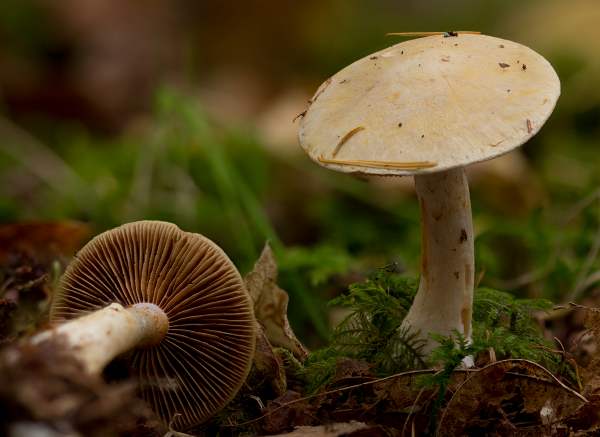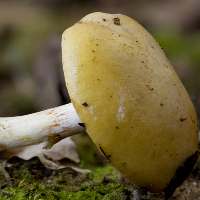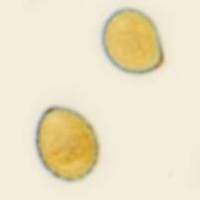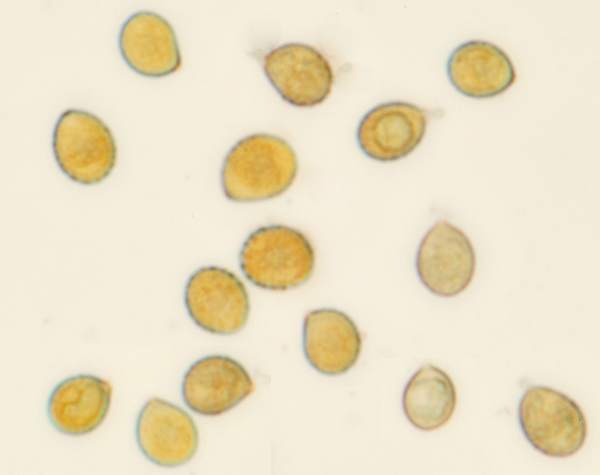Cortinarius delibutus Fr. - Yellow Webcap
Phylum: Basidiomycota - Class: Agaricomycetes - Order: Agaricales - Family: Cortinariaceae
Distribution - Taxonomic History - Etymology - Toxicity - Identification - Reference Sources

In the difficult Cortinarius group of fungi Cortinarius delibutus is distinguished by its sticky/slimy yellow cap and stem and bluish gills (when young).
Distribution
Cortinarius delibutus is fairly common in Britain and Ireland and is recorded also from many parts of mainland Europe.
Taxonomic history
In 1838 the famous Swedish mycologist Elias Magnus Fries described the Yellow Webcap and gave it the scientific name Cortinarius delibutus. This remains its generally-accepted scientific name.
Synonyms of Cortinarius delibutus include Cortinarius fulvoluteus Britzelm., Cortinarius naevosus Fr., Cortinarius suratus Fr., Gomphos delibutus (Fr.) Kuntze, Gomphos naevosus (Fr.) Kuntze, and Gomphos suratus (Fr.) Kuntze.
The vast genus Cortinarius is subdivided by many authorities into subgenera, and Cortinarius delibutus belongs to the subgenus Myxacium.
Etymology
The generic name Cortinarius is a reference to the partial veil or cortina (meaning a curtain) that covers the gills when caps are immature. In the genus Cortinarius most species produce partial veils in the form of a fine web of radial fibres connecting the stem to the rim of the cap.
The specific epithet delibutus means greasy.
Toxicity
Because several of the webcaps are known to be deadly poisonous (and some research even suggests that all Cortinarius species may contain at least small amounts of the toxins concerned), in our opinion webcaps should never be gathered for eating.
Identification guide
 |
CapThe greasy (slimy when wet) hemispherical to convex yellow caps of Cortinarius delibutus are 3-6cm in diameter and eventually become flattened or even slightly depressed in the centre, but the margin remains inrolled or at least downturned. Flesh yellowish, with a faint bluish tinge in young specimens. A short-lived yellowish cortina joins stem to cap rim of young fruitbodies, concealing the immature gills. |
 |
GillsAdnate, moderately spaced to distant; at first violet or bluish, becoming buff tinged with violet as the spores mature. StemFinely fibrillose, 5-9cm long and 3-6mm in diameter, clavate or sometimes slightly bulbous at base; surface sticky (slimy in wet weather), covered with yellowish veil remnants that stain rust-brown once spores begin to fall. |
 |
BasidiaFour-spored. SporesEllipsoidal to subspherical; coarsely verrucose (with a roughened surface), 7-9.5 x 6-7µm. Spore printRusty-brown. |
Odour/taste |
Odour not distinctive. Taste reported to be mild, but it is generally considered unwise to taste any Cortinarius species because several of them are deadly poisonous. |
Habitat & Ecological role |
Mycorrhizal, particularly with Beech and Birch but also occasionally in mixed woodland with Spruce. |
Season |
August to December in Britain and Ireland. |
Similar Species |
Cortinarius triumphans is a larger yellow webcap with much longer spores. |
Reference Sources
Fascinated by Fungi, 2nd Edition, Pat O'Reilly 2016, reprinted by Coch-y-bonddu Books in 2022.
Funga Nordica, Henning Knudsen and Jan Vesterholt, 2008.
British Mycological Society, English Names for Fungi
Dictionary of the Fungi; Paul M. Kirk, Paul F. Cannon, David W. Minter and J. A. Stalpers; CABI, 2008
Taxonomic history and synonym information on these pages is drawn from many sources but in particular from the British Mycological Society's GB Checklist of Fungi.
Acknowledgements
This page includes pictures kindly contributed by David Kelly.
Fascinated by Fungi. Back by popular demand, Pat O'Reilly's best-selling 450-page hardback book is available now. The latest second edition was republished with a sparkling new cover design in September 2022 by Coch-y-Bonddu Books. Full details and copies are available from the publisher's online bookshop...


